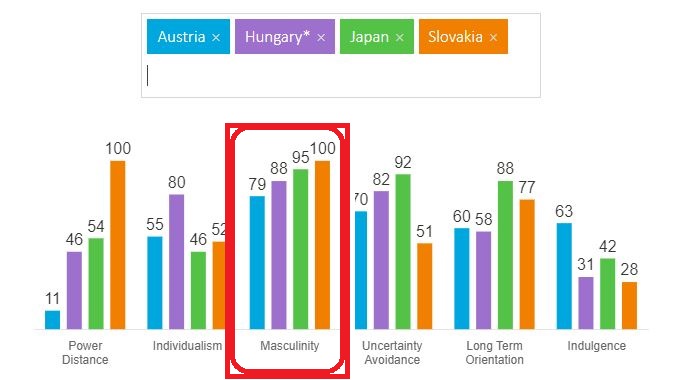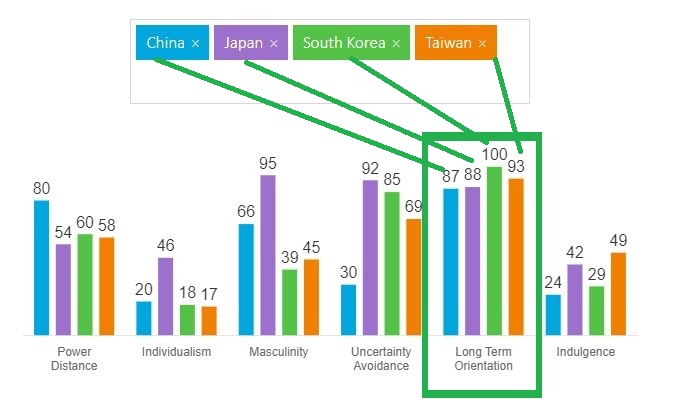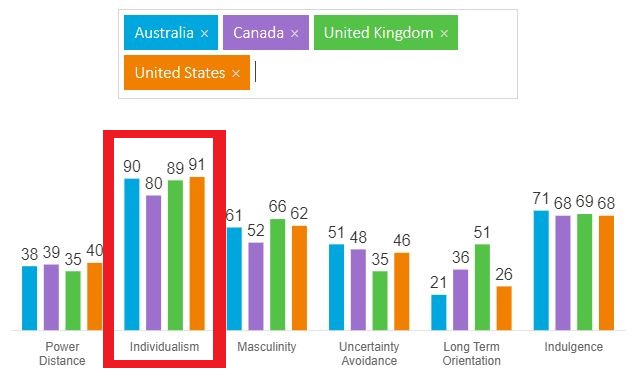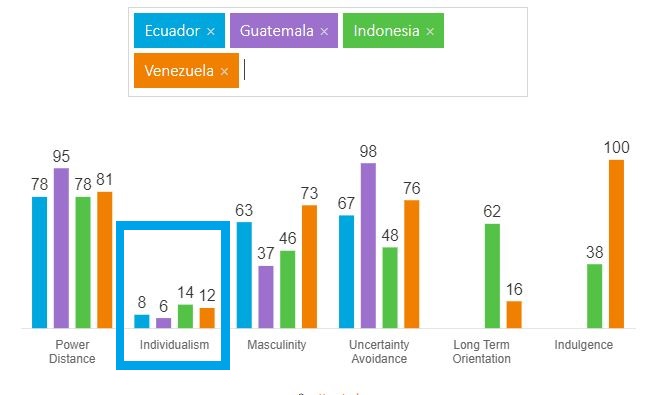Hofstede’s Cultural Dimensions Theory. Also, Definition and Examples of Geert Hofstede’s Six Cultural Dimensions.
Hofstede’s Cultural Dimensions
Hofstede’s cultural dimension was developed in 1980 by Dutch management scholar Geert Hofstede. It is also known as Hofstede’s model and theory. Geert Hofstede’s cultural dimensions refer to the conceptual framework identifying cultural differences worldwide. It systematically compares the nations based on beliefs, values, behaviors, and attitudes. Hence, Hofstede’s cultural dimensions theory shows the effects of a society’s culture on the values of its members. It also uses a structure derived from factor analysis to show how these values relate to behavior.
Initially, Hofstede’s cultural dimensions theory has only four dimensions: power distance index, individualism vs. collectivism, masculine vs. feminine, and uncertainty avoidance index. In 1988, Michael Harris Bond added the 5th dimension, “Long-Term versus Short-Term Orientation,” to Hofestede’s model. Similarly, in 2010, Michael Minkov described and added the 6th dimension, named indulgence vs. restraint, to Geert Hofstede’s theory. Therefore, it is also known as Hofstede’s dimensions of national culture that evaluates and represents cultural differences globally.
This model generates rank for each country through contained scores on a specific dimension. Each dimension of the Hofstede model differs from others for its unique factor analysis. Hence, it is one of the critical theories to understand the cultural differences prevalent across the country. Cultural difference creates cultural conflict, also known as the cultural noise in communication.
Hofstede’s Six Cultural Dimensions
Geert Hofstede’s 6 Cultural Dimensions are Power Distance Index (PDI), Individualism Vs. Collectivism, Masculinity Vs. Femininity, Uncertainty Avoidance Index (UAI), Long Vs. Short-Term Orientation and Indulgence Vs. Restraint. This cultural dimensions theory is beneficial to understand and change the work attitude of the organization, group, team members, and so on. This model enables group members to negotiate with others in group communication. It also assists the negotiators in understanding the opposite party during international negotiations. Hofstede’s cultural dimensions are a significant model of communication that contributes to international and cross-cultural communication.
Hofstede’s 6 Cultural Dimensions are:
- Power Distance Index (PDI)
- Individualism Vs. Collectivism
- Masculinity Vs. Femininity
- Uncertainty Avoidance Index (UAI)
- Long Vs. Short Term Orientation
- Indulgence Vs. Restraint

1. Power Distance Index(PDI)
(Extent of Inequality and Power Distributed in Society)
The power distance index refers to the degree to which society members accept the distance of power and authority. It is a crucial element of Hofstede’s six cultural dimensions that assess the inequality (more versus less) among group members of society. Additionally, it has a significant impact on international business negotiation. The power distance index differs into high power and low power distance index.
High Power Distance
The high power distance refers to a society where less powerful people easily accept the unequal power distribution in the community. It means the acceptance of the inequity between high- and low-status members of society. People with High PDI expect power to be distributed unequally, so they do not complain about inequality. It has become a tradition that they convey from generation to generation. They value traditional norms and social rules. Therefore, people in high power distance countries accept the inequity in organizations.
Examples of High Power Distance Countries
Bangladesh, China, India, Singapore, Malaysia, and Arab countries have very high power distance scores; therefore, these countries are examples of high PDI in 2023. For example, Bangladesh and China ranked high power distance countries with scores of 80. Additionally, India scores 77, and Singapore scores 74 in the power distance dimension. People from the following countries easily accept the inequalities between people with high and low power status. People in these countries do not complain; they admit it as a social order.
Hofstede country comparison website: www.hofstede-insights.com. Anyone can compare the country’s culture through the following link.
Low Power Distance
Low power distance refers to a culture where less powerful people do not accept unequal power distribution in society easily. It means the acceptance of equity and equality between high- and low-status members of society. The member of the community practices fairness and interdependence activities in society. People in a low PDI society are pragmatic; hence, they are less orientated to traditional values. They also complain about the subsisting inequity between high- and low-status members in communities and organizations.
Examples of Low Power Distance Countries
Austria, Israel, Denmark, New Zealand, Norway, Germany, and the United Kingdom are examples of low power distance countries in 2023. According to Hofstede’s cultural dimensions theory, Austria has achieved the lowest PDI country with 11, following Israel with 13, Denmark with 18, New Zealand with 22, Norway with 31, Germany with 35, and the United Kingdom with 35. People from these countries do not accept the inequity between high and low-influential people in society, community, and organization. They also raise their voices against injustice and discrimination in society.
Differences Between High and Low Power Distance Culture
High Power Distance Culture |
Low Power Distance Culture |
| People certainly accept unequal power distribution in society. | In contrast, people complain about unequal power distribution. |
| Juniors respect senior people who are older than 50 in society. | Senior and junior people respect each other equally. |
| Discrimination is prevalent in every sector of the country; for example, social, government, and non-government organizations. | On the other hand, people raise their voices against discrimination. |
| The political leader and organizational boss are autocratic people. | The political leader and organizational boss are democratic people. |
| For example, high power distance cultures exist in Bangladesh, China, India, Singapore, Malaysia, and Arab countries. | For example, low power distance cultures exist in Austria, Israel, Denmark, New Zealand, Norway, Germany, and the United Kingdom. |
2. Individualism Vs. Collectivism
(Prefer To Work Independently or Interdependently)
Individualism and collectivism are the most significant cultural dimensions that separate the society where people prefer to work personally or interdependently. According to Hofstede’s model, a high score in the country indicates an individualistic culture. On the other hand, the low score indicates a collectivistic culture. Hofstede’s cultural dimensions theory encourages a collectivistic culture, so the members of an individualistic society should understand that they are part of a larger group. Therefore, they should make all-out efforts to achieve a shared goal. Tuckman’s communication model discusses how to work together in a group to achieve common goals.
Individualism
Individualism refers to the individualistic culture of society where people prefer to work separately and seek freedom in the workplace. Individualistic members like to work alone and seek credit for their work. In this culture, task prevails over relationships in the workplace. People in individualistic cultures do not want to work in groups, so they set independent goals and appreciate freedom. Thus, they are assertive, self-reliant, competitive, and value individual achievement.
Individualistic Countries Examples
Usually, individualist cultures are prevalent in Western countries. For example, the United States, Australia, United Kingdom, Canada, Netherlands, New Zealand, and Ireland are individualistic countries. According to Hofstede’s Dimensions of National Culture, the United States scores 91, following Australia with 90, the United Kingdom with 89, Canada with 80, the Netherlands with 80, New Zealand with 79, and Ireland with 70. Therefore, people from these countries prefer to work alone and foster independent achievement.
Collectivism
Collectivism refers to the collectivistic culture of society where people prefer to work together and foster interdependent achievement. Collectivist members like to work in groups and try to help each other. They like to work in groups instead of working alone. In this culture, relationship prevails over tasks in the business setting. They also enhance group identity and group success. Hence, they are cooperative, obedient, and self-sacrificing. The family member maintains strong relationships with members in collectivism. On the other hand, family members do not focus on maintaining strong relationships in an individualistic society.
Collectivistic Countries Examples
Collectivist cultures are common in Asian and Latin American countries. Guatemala, Ecuador, Venezuela, Indonesia, Pakistan, Taiwan, South Korea, China, Bangladesh, and Malaysia are considered the most collectivistic nations globally. According to Hofstede’s cultural dimensions model, a low score in this dimension indicates a collectivistic society. For example, Guatemala has ranked the most collectivistic country in the world with a score of 06, following Ecuador with 08, Venezuela with 12, Indonesia with 14, Pakistan with 14, Taiwan with 17, South Korea with 18, China with 20, Bangladesh with 20, and Malaysia with 26. So, people from these countries prefer to work in groups and intend to achieve shared goals.
Hofstede Cultural Dimensions Masculinity vs. Femininity
Differences Between Individualistic and Collectivistic Culture
Individualistic Culture |
Collectivistic Culture |
| Firstly, People are intended to work alone. | In contrast, people are intended to work in a group or team. |
| Additionally, people foster personal achievement. | People foster group achievement. |
| In this culture, the member takes responsibility only for the immediate family, including the wife and children. | On the other hand, in a collectivistic society, the member takes responsibility for the extended family, including parents and grandparents. |
| In the workplace, employees are supposed to focus on personal tasks, and they compete with each other for positions. | In contrast, employees are supposed to share the workload. |
| Tasks control the relationship | However, relationship prevails over tasks. |
| Government plays a small role in society. | The government certainly plays the most critical role in society. |
| Above all, people are assertive, self-reliant, self-interested, competitive, and independent. | Whereas People are obedient, self-sacrificing, cooperative, and interdependent. |
| I- Consciousness | We- Consciousness |
| For example, individualistic cultures are prevalent in the United States, Australia, the United Kingdom, Canada, the Netherlands, New Zealand, and Ireland. | For example, collectivistic cultures are prevalent in Guatemala, Ecuador, Venezuela, Indonesia, Pakistan, Taiwan, South Korea, China, Bangladesh, and Malaysia. |
3. Masculinity Vs. Femininity
(Assertiveness and Nurture Society)
Masculinity versus femininity is another dimension of Hofstede’s theory that differentiates society based on gender roles and traits. The high score of the dimension refers to the masculine culture driven by competition and material success. On the other hand, the low score indicates a feminine society driven by the quality of life.
In business circumstances, masculinity versus femininity refers to “tough versus tender” cultures.
Masculinity
Masculinity pertains to traits associated with assertiveness culture in society. According to Geert Hofstede’s cultural dimensions, men focus on personal tasks and material success in masculine culture. The roles of males and females overlap less than in feminine society. The men are more assertive, decisive, dominant, and focused on success. On the other hand, women are more humble, loving, and focused on quality of life. In this society, men concentrate on assertiveness, heroism, and performance. The men of these societies are more competitive than feminine societies. Children in China learn the importance of personal achievement since childhood. So, they compete with each other for self-success.
In business settings, masculinity refers to the rough culture in the organization. The Boss does less discussion with employees to make- decisions.
Examples of Masculine Countries
Slovakia, Japan, Hungary, Austria, Venezuela, Italy, Mexico, and China are considered masculine countries for their high score in this dimension. For example, Slovakia scores 100, following Japan(95), Hungary(88), Austria (79), Venezuela (73), Italy 70, Mexico (69), and China (66). So, the gender roles of these countries are specific and overlap very little.

Feminine
Femininity denotes traits associated with nurture culture in society. The members of feminine society focus on relationships and quality of life. They are nurtured, cooperative, modest, and caring to other members of society. They also maintain modest behavior in the community and organization.
In the business context, femininity refers to the tender culture in the organization. The Boss does great discussion and intuitive analysis to make decisions.
Examples of Feminine Countries
Sweden, Norway, Netherlands, Denmark, Costa Rica, and Finland are considered the most feminine countries globally for their low MAS score in this dimension. According to Hofstede’s cultural dimensions theory, Sweden ranked the most feminine country in the world with a score of 5, following Norway (8), Netherlands (14), Denmark (16), Costa Rica (21), and Finland (26). So, the gender roles of these countries are fluid and overlap significantly.

4. Uncertainty Avoidance Index (UAI)
(Extent of Comfort in Uncertain Situations)
The uncertainty avoidance index describes how people from different countries deal with ambiguous situations. It also identifies the people who are comfortable in uncertain moments and who are scared to encounter unwanted difficulties. According to Geert Hofstede’s cultural dimensions, the uncertainty avoidance index differs into two categories: high uncertainty avoidance and low uncertainty avoidance index.
High Uncertainty Avoidance
People in high uncertainty avoidance societies thoroughly follow the rules and regulations to avoid undesirable moments. They prefer to follow routines and make plans to prevent unpredictable moments. They also believe proper planning is essential for achievement; hence, parents control their children’s lives excessively. People in high UAI-scoring countries are more traditionalistic, stiff, and structured. The structured person tends to do the right things and avoid unwanted consequences.
Examples of High Uncertainty Avoidance Countries
Greece, Guatemala, Russia, Portugal, Belgium, and Japan are the highly uncertain avoidance countries. According to Hofstede’s cultural dimensions theory, Greece has become the highest uncertainty avoidance country with a score of 100, following Guatemala (98), Russia (95), Portugal(95), Belgium(94), and Japan(92). So, people from these countries prefer to lead a planned life to avoid unwanted risks.

Low Uncertainty Avoidance
People in low uncertainty avoidance societies are comfortable with undesirable moments. They mainly act first before garnering enough information. They are not intended to follow all rules and regulations thoroughly, so they work to reduce unnecessary rules from society and organizations. People in low UAI countries are relaxed and open-minded; therefore, they are not scared to encounter uncertainty and unpredictability.
Examples of Low Uncertainty Avoidance Countries
Singapore (8), Jamaica(13), Denmark(23), Hongkong(29), Sweden (29), and also Malaysia 36 are examples of low uncertainty avoidance countries. People from these low UAI countries accept the risk easily and are not scared to encounter unwanted situations.

5. Long Vs. Short Term Orientation
(Pragmatic Versus Normative)
Long versus short-term orientation is a crucial dimension of the Geert Hofstede theory that categorizes society based on pragmatic and normative actions. Michael Harris Bond added this dimension in 1988. It assists in measuring the tendency of long-term or short-term results. It also describes how people deal with the past, present, and future.
Long Term Orientation
People in long-term orientation are focused on the future and consider it more valuable than the past. They tend to spend a lot of time to achieve long-term results. The members of the long-term orientated society are practical, modest, and more careful. They also encourage others to utilize time and money properly to achieve the goal.
Examples of Long Term Orientation Countries
According to Geert Hofstede’s cultural dimensions theory, South Korea(100), Taiwan(93), Japan (88), China(87), Germany(83), and Singapore(72) are the long-term orientation countries in the world. So, people from these countries set long-term goals and expect perseverance and satisfaction.

Short Term Orientation
People in short-term orientation are focused on the past and the present, considering them more valuable than the future. They prefer to enjoy the current situation regardless of their future goal. The members in the short-term orientated society are spiritual, normative, and nationalistic.
Examples of Short-Term Orientation Countries
According to Hofstede’s cultural dimensions model, Ghana(4), Nigeria(13), Australia(21), United States(26), Philippines(27), and also Norway(35) are considered as the short-term oriented countries in the world. So, people from these countries set short-term goals and expect immediate satisfaction.

6. Indulgence Vs. Restraint
Indulgent versus restraint stands for cultures that allow people to enjoy or suppress gratification. In the 21st century, Michael Minkov described the six dimensions and extended the Hofstede theory.
Indulgence
Indulgence refers to a society where many people acknowledge that they are leading a happy life. People in an indulgent society enjoy life freely; hence, they have fun and obtain optimistic attitudes. They prioritize having friends, playing games, and spending leisure time appropriately.
Examples of Indulgent Countries
According to Hofstede’s cultural model, the most indulgent countries in the world are Venezuela(100), Mexico(97), Puerto Rico(90), El Salvador(89), Nigeria(84), Colombia(83), Germany(83), Trinidad and Tobago(80), Sweden(78), Australia (71), Canada(68), Australia(68), and also Argentina(62).

Restraint
Restraint refers to a society where fewer people declare they are leading a happy life. People in a restrained community suppress gratification and do not focus on the freedom of speech. Additionally, they handle life according to traditional norms and have pessimistic attitudes.
Examples of Restraint Countries
According to Hofstede’s model, the restraint countries in the world are Pakistan(0), Egypt(4), Latvia(13), Ukraine(14), Albania(15), Belarus(15), Estonia(16), Iraq917), Russia(20), and also China(24).
Differences Between Indulgent and Restrained Societies

The two additional dimensions of global cultural differences are high context versus low context and monochronic versus polychronic time. In 1976, Edward T. Hall introduced these cultural dimensions that distinguish one from another nation.
High Context Vs. Low Context
High context: Members consider background, interpersonal history, and nonverbal cues when communicating. Messages are implied and context-sensitive example, Japan, China, Greece, and Mexico.
Low Context: Low-context members want facts and clear, direct communication. Messages are explicit, factual, and objective—for example the US, England, and Germany.
Monochronic Versus Polychronic
Monochronic: Monochronic members focus on one task at a time and work hard to meet deadlines. They also adhere to plans, schedules, and time because time is valuable. For example, people in North America and Northern Europe are mostly monochronic.
Polychronic: Polychronic members are continually late, do many things at once, are easily distracted, and endure interruptions. Additionally, they are not obsessed with schedules because time is not highly valued. For example, people in Kenya, Argentina, African America, and Asia are polychronic. The monochronic versus polychronic time is a chronemic nonverbal communication.
Conclusion
In conclusion, Hofstede’s Dimensions of National Culture are the Power Distance Index (PDI), Individualism Vs. Collectivism, Masculinity vs. Femininity, Uncertainty Avoidance Index (UAI), Long Vs. Short-Term Orientation and Indulgence Vs. Restraint. It is an important tool for a friendly environment in an international organization.
Hofstede’s Cultural Dimensions Theory Strengths and Weaknesses
Strengths:
- Cross-Cultural Understanding: Hofstede’s dimensions provide a systematic framework for understanding cultural differences across nations. By identifying key dimensions such as individualism-collectivism, power distance, and uncertainty avoidance, the theory helps individuals and organizations better understand cultural nuances and adapt their behavior accordingly in cross-cultural interactions.
- Practical Applications: The dimensions can be applied in various contexts, such as international business, education, healthcare, and diplomacy. For example, understanding cultural differences in communication styles or leadership preferences can help multinational corporations tailor their strategies and operations to be more effective in diverse cultural environments.
- Research Validity: Hofstede’s research was based on extensive surveys of IBM employees across different countries, providing a solid empirical foundation for his dimensions. While the data may be somewhat dated, subsequent research in cross-cultural psychology and sociology has validated and extended the theory.
Weaknesses:
- Simplification of Cultures: Geert Hofstede’s dimensions reduce complex cultural phenomena into a limited number of dimensions, potentially oversimplifying the diversity within cultures. Cultural traits are often more nuanced and multifaceted than can be captured by a few dimensions, leading to the risk of stereotyping or generalizing about cultural groups.
- Limited Contextual Consideration: The dimensions may not fully account for the influence of historical, social, economic, and political factors on cultural differences. Cultural dynamics can vary within countries or regions and change over time, challenging the universality and stability of Hofstede’s dimensions.
- Ethnocentrism and Bias: Critics argue that Hofstede’s research was conducted from a Western-centric perspective, potentially biasing the dimensions toward Western cultural values and norms. The dimensions may not fully capture the diversity of non-Western cultures or adequately represent marginalized or minority groups within societies.
- Lack of Individual Variation: The dimensions primarily focus on broad cultural tendencies at the national level and may overlook individual variation within cultural groups. People within the same culture may exhibit different behaviors and values due to factors such as age, gender, education, and socioeconomic status.
What is Culture?
Culture is a set of values, beliefs, attitudes, behaviors, symbols, and norms people share in a society or community. The cultures vary from country to country and community to community. For example, Malaysian culture is not similar to Australian culture. Additionally, the culture of African Americans is not similar to White Americans.
Citation for this Article (APA 7th Edition)
| Kobiruzzaman, M. M. (2024). Hofstede’s Cultural Dimensions- Hofstede’s 6 Cultural Dimensions Examples. Newsmoor- Best Online Learning Platform. https://newsmoor.com/cultural-dimensions-hofstedes-cultural-dimensions-theory-with-six-dimension/ |




I have enjoyed reading this very informative article .
It is really great informative article. I have enjoyed reading the article.
I am amazed with this topic.
Great informative research on how society interacts
I really liked it.
Very interesting
Very interesting topic. I found the information very useful.
i really like this
Article very interesting.
This page is so useful
Great work, but is the graph “Geert Hofstede’s Six Cultural Dimensions” accurate? I find that subframes one and two are inverted. PDI subframe (1 of 6) shows below an ilustration that says “work alone or group”, whereas the Individualism vs Collectivisim subframe (2 of 6) shows an illustration of “extend of power in society”.
Besides that, I have really enjoyed reading the article. Despite being short and easy it properly conveys. Thanks